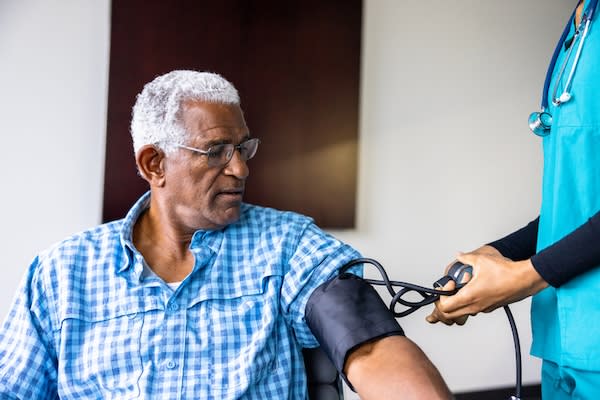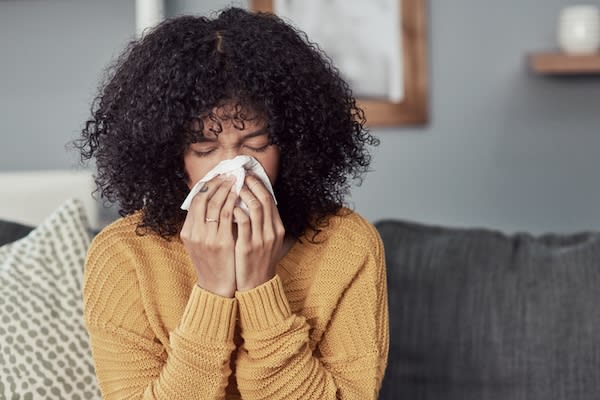Understanding post-traumatic stress disorder
[3 MIN READ]
In this article:
-
Post-traumatic stress disorder can occur after a significant life event or trauma. It's different from anxiety, which is prompted by a wide range of events and circumstances.
-
About 8 million people in the U.S. are currently suffering from PTSD.
-
June is PTSD Awareness Month, with events and messaging dedicated to spreading awareness about available treatment options.
Fear and anxiety are natural responses to a traumatic event. They prompt your body’s fight or flight response, causing a rush of hormones that heighten your awareness and make you more alert. Once you no longer feel threatened, you calm down, those hormones subside, and your body returns to “normal.”
When those stress reactions continue for several weeks and your anxiety level remains on high alert, it could be post-traumatic stress disorder (PTSD). June is PTSD Awareness Month. The annual event focuses on raising awareness and spreading the word about available treatments.
“The pandemic has created a heightened, sustained level of anxiety for the last two years. Add in the highly charged political environment, the stressors caused by the economy and the ongoing trauma of violence around the country, and we’re all at higher risk these days” says Dr. Robin Henderson, Chief Executive, Behavioral Health for Providence Oregon. “For people who have experienced trauma, the risk is even higher.”
Is it post-traumatic stress disorder or anxiety?
Although they share several characteristics, anxiety and PTSD are not the same.
Anxiety produces feelings of dread and uneasiness that occur in response to a wide range of situations and circumstances. It’s a normal reaction to stress that fades as the stressor resolves itself.
PTSD, however, is a response to a major life event or trauma that’s shocking, scary, or dangerous. It can develop at any age and affect anyone, including combat veterans, abuse victims, people with chronic or terminal illnesses, and children. About eight million people in the United States have PTSD, according to the National Center for PTSD.
Symptoms and types
PTSD symptoms usually begin within three months of the triggering event, but they can appear at any time in its aftermath. To be considered PTSD, your symptoms must last at least a month, cause great distress and be severe enough to disrupt your daily life.
There are four main types of PTSD.
Dr. Henderson says, “It’s essential to work with a mental health professional to determine what type of PTSD you may be experiencing. Some symptoms respond better to therapy than others, and some may require medication support.”
Re-experiencing symptoms
This type of PTSD occurs when you repeatedly re-live the trauma you’ve experienced and continue to feel extreme fear and distress. It causes flashbacks, nightmares, and physical signs of stress.
Avoidance symptoms
With avoidance symptoms, you steer clear of people, places, and situations that remind you of the traumatic event and trigger your stress response. For example, if you were involved in a car accident, you may refuse to drive. You may also avoid thinking about the trauma and block it from your mind as much as possible.
Arousal and reactivity symptoms
Arousal symptoms keep you on the lookout for danger. You may be easily startled and have difficulty concentrating. Anger, irritability, and aggressive outbursts are regular occurrences. You may also have trouble sleeping, eating, or being an active participant in your daily routine.
Cognition and mood symptoms
Cognition and mood symptoms affect your feelings and beliefs. They may prompt isolation and detachment from family and friends. You could experience negative, distorted thoughts and reoccurring negative emotions such as guilt, blame, anger, and shame.
Children and PTSD
A child’s age and development often determine how they experience PTSD after a traumatic or frightening event. Symptoms in children and adolescents may differ from adults. But for many, a common denominator is a feeling of helplessness and anxiety.
“If you suspect your child may have PTSD, it’s important to work with your pediatrician or other healthcare professional, as PTSD is often mistaken for Attention-Deficit/Hyperactivity Disorder,” says Dr. Henderson.
Symptoms in children younger than six include:
- Bedwetting
- Difficulty sleeping
- Inability or refusal to speak
- Separation anxiety from parents or other caregivers
Children aged seven to 11 often:
- Act out their trauma through stories, artwork or play
- Become agitated, irritable or aggressive
- Experience nightmares or night terrors
- Have difficulty with schoolwork or attempt to avoid school
From ages 12 through 18, adolescent’s symptoms tend to resemble those experienced by adults, including:
- Anxiety
- Depression
- Risky, dangerous behavior
- Substance abuse
- Thoughts of revenge and retribution
- Withdrawal
PTSD resolves itself within a few months of the traumatic event for many children and adolescents. Treatment such as trauma-focused talk therapy or medication may be required for children whose symptoms linger or cause disruption in their lives and relationships.
PTSD and COVID-19
The aftermath of COVID-19 and its impact on nearly every aspect of day-to-day life have triggered PTSD symptoms in adults and children. Isolation, medical challenges, and the loss of loved ones have increased feelings of panic, anger, and hopelessness. For many, new behaviors such as crowd avoidance or fear of public spaces are a signal help is needed.
“All of us have experienced loss of some kind during this pandemic” says Dr. Henderson. “It’s important to take time and acknowledge how the pandemic has impacted you and your family, and make time to grieve and recover.”
Although the pandemic has affected everyone in some way, you may be at increased risk of PTSD if you:
- Lost friends and family to COVID-19
- Survived COVID-19
- Experienced financial difficulties and economic hardships
- Are a frontline worker who’s regularly exposed to COVID-19
- Experienced extreme isolation due to social distancing
Coping skills and trauma recovery
Developing your coping abilities and learning effective ways to deal with your stressors improves your overall quality of life. These tips from the National Institute of Health can get you started:
- Stay connected to others by sharing your experiences and feelings.
- Calm yourself with meditation or deep breathing exercises.
- Include physical activity such as yoga or walking in your regular routine.
- Practice self-care by making healthy choices such as getting enough sleeping, being physically active, and eating a balanced diet.
- Avoid tobacco, drugs, and excessive alcohol use.
- Get involved with your community or causes you care about
When do I need help?
If you suffer from PTSD, professional help through therapy and/or medication can often provide solutions and strategies to help you reclaim your life. Talk to your doctor if you have symptoms that disrupt your life that last longer than a month.
“At some point in their lifetime, 1 out of 5 people will have a mental illness,” says Robin Henderson, PsyD. “You don’t have to suffer in silence. There’s no shame in asking for help.”
--
Find a doctor
If you are looking for a primary care doctor or mental health provider, you can search for one who’s right for you in our provider directory.
Download the Providence App
We’re with you, wherever you are. Make Providence’s app your personalized connection to your health. Schedule appointments, conduct virtual visits, message your doctor, view your health records, and more. Learn more and download the app.
Related resources
Mental health disorders in children: What to know
Teen suicide: Know the warning signs
Dealing with PTSD: A real-life story from Bellator fighter Cat Zingano
Providence Montana - HealthBreak - PTSD & Pain
This information is not intended as a substitute for professional medical care. Always follow your health care professional's instructions.



